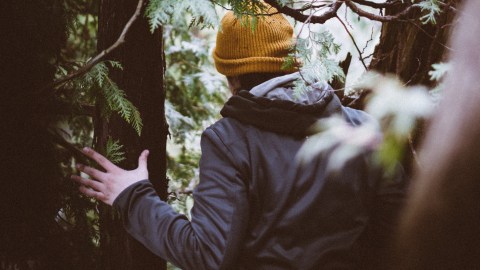How geocachers navigate fear in the urban woods

Photo by Kyle Peyton on Unsplash
On a drizzly Saturday morning in June 2018, I found myself kneeling on the edge of a wooden boardwalk in Melbourne’s northern suburbs.
My right arm was hooked over the side, fingers gathering cobwebs and dust as they probed the rough pine of the planks. I hoped for the smooth sensation of plastic or metal rather than the squish of a creepy-crawly.
I looked over at my partner on this expedition: sharkiefan, as she’s known in the geocaching community, a pharmacist from New Zealand. She was sprawled on her stomach across the boardwalk, with her shoulder jammed in for maximum reach. Before I could suggest she move into a less hazardous formation, a man on a bicycle swerved and braked to avoid her outstretched legs. He shuddered to a halt, plastic poncho swirling.
“What are you after there? Flowers?” he asked. His eyes were wide behind his raindrop-covered glasses. “No,” said sharkiefan, calmly rolling into a sitting position. “We’re looking for geocaches.”
“Oh,” he said. He continued to watch as sharkiefan made a last-ditch effort for the geocache (which our GPS assured us, unconvincingly, was right there). Then he rode away, poncho flapping. With the rain starting to spatter, sharkiefan hauled herself up and decided it was a DNF (did not find)—for the moment, at least. “Besides, that guy was kinda creepy,” she said. “I didn’t wanna keep looking for it while he was watching us.”
At the time, I was an anthropology student in Melbourne studying geocachers, or people who play geocaching. Geocaching is one of the many location-dependent digital games that have proliferated since smartphones with GPS capabilities became common in the mid-2000s. You can think of it as a kind of multiplayer treasure hunt, where players use GPS and a digital map to hide and search for containers (geocaches) filled with trinkets.
Because geocaches are always hidden out of sight, players often have to behave in out-of-the-ordinary ways to reach them. They might have to climb a tree, crawl through bushes, or flatten themselves on a boardwalk like sharkiefan and I did. The way they use public space departs sharply from social norms, without providing any obvious motives to passers-by.
When onlookers are left to fill in the blanks, they often assume some kind of deviant behavior. For instance, vividrogers, an avid creative writer and stay-at-home mom, recounted the time she had squatted under some pines to sign a cache’s logbook. At that moment, a family came past. She told me sheepishly, “The mum said, ‘Let’s not go this way, kids,’ because it looked like I was doing a wee or something.”
As I did my field research, I became more and more interested in how this unusual behavior makes some geocachers appear sexually threatening and others feel sexually vulnerable—usually depending on their gender. A man ferreting in the undergrowth might notice suspicious gazes. And a woman sprawled on a boardwalk might feel uneasy when a man takes an interest in her “flower gathering.”
People playing mobile locative games—like geocaching or Pokémon GO—are often perceived to inhabit a somewhat trivial world belonging to a subculture all their own. But, as my experiences highlight, they are in fact deeply entangled with the political currents of the everyday world. They, too, are impacted by the social norms and current events that establish gendered assumptions and provoke fear.
The winter sun dipped in the sky as I wrapped up an interview with Peter, a chemistry teacher in his early 40s, at a café in southeast Melbourne. After our chat, we drove our separate cars to the nearby Valley Reserve, a tranquil, densely vegetated park, where we planned to do some geocaching. It was getting dark under the trees, and only a couple of other vehicles were parked on the far side of the lot.
We pulled up next to each other and got out. As we juggled notebooks and GPSs, Peter remarked, “Shouldn’t you have a chaperone? Going into a bushy park with a strange man—I don’t know, if it was my daughter, I would want her to have a chaperone.”
Peter’s comment flustered me. I ducked my head to hide my embarrassment and frustration. Not only had he verbalized the irrational fears I’d spent the whole day trying to dismiss from my own mind, I was also more than a little disgruntled at the idea of needing a chaperone.
The previous week, the news and social media had been swamped by stories about Eurydice Dixon, a young woman who was raped and murdered by a man in a Brunswick park in north Melbourne. The statistical likelihood of experiencing such violence from a stranger in Melbourne—one of the safest cities in the world—is miniscule. But the news had piqued everyone’s anxieties, and concern about the potential for violence was in the air. It was on my mind. Presumably, it was on Peter’s too.
But then again, people around me had expressed similar concerns long before this awful murder had brought the issue to the fore. Before my research had even begun, my university’s ethics committee had made me resubmit my application with better risk-management strategies. “As a young female student … Is it safe for the researcher to travel alone with the unknown geocacher in a park or other abandoned areas?” they wrote. Each time I left for an interview with a male participant, my parents made me text them the name of the interviewee and our meeting place. While I took reasonable precautions, I wanted to put these worries in their place. Statistically, violence was so unlikely, it seemed unfair that the fear of it could exert so much control over my life.
What surprised me about Peter’s comment was that the person who appeared as the “threat” in this narrative had voiced misgivings himself. Perhaps he had been trying to diffuse any tension, as if a perpetrator wouldn’t be so frank about such things. To fully disperse that tension, I should’ve laughed it off, saying something like, “Oh, but I’m sure you’d never do something like that!” Unfortunately, I tend to strive for accuracy more often than I strive for social harmony. What I actually said was, “Well, I suppose you have to take risks.”
On that somewhat dark note, we set off.
The day after Eurydice Dixon was murdered, I was cycling to Brunswick for an interview with vividrogers. Losing my bearings, I turned up alongside an expansive park and paused to check Google Maps. Then I saw the police cordon stretched across the grass of the soccer pitch. I realized, with a visceral jolt, that I knew exactly where I was.
Vividrogers, like many of the female geocachers I spoke to, said she was unlikely to go geocaching by herself at night: “It definitely occurs to you. As a female in today’s society, I probably wouldn’t wander around in a dark park in the middle of the night on my own.”
Rod, a truck driver and respected member of the geocaching community, often takes women on nighttime geocaching expeditions. He acts as a kind of “chaperone,” to use Peter’s term. He does know female geocachers who go out at night alone, but just like my parents and the ethics committee, he worries about them. “And there are grounds to worry,” he said, “based on recent happenings in Melbourne.”
Sharkiefan, though, isn’t afraid of the dark. Rod has invited her on his night expeditions before, but she wouldn’t limit herself to night-caching with a male companion. “I feel safe in the city,” she said. “It doesn’t mean I’d go down an alley, but you just have to be sensible.”
The assumptions that make women feel vulnerable at times can, in other contexts, act in their favor. One of the things that sharkiefan loves about geocaching is that she can sneak through a park full of children and parents, rummaging under benches and peering into foliage, without anyone taking much notice. At a glance, she isn’t assumed to be threatening. “Being a white girl, and being middle-aged, well, you can kinda just do what you like,” she told me once over brunch. “No mums and dads give me a second look because I’m not a guy and I’m not gonna be some child molester or something.” Without a partner or children beside them, lone male geocachers in parks are sometimes interpreted as gay men wanting casual sex in the toilet block, or as potential pedophiles, she explained.
Race plays into these assumptions too. But this is less noticeable in geocaching, because most players are white—in fact, a study conducted in the U.S. found that 96 percent of geocachers identified as white, a statistic that matched my own experience in Melbourne. You could even speculate that geocaching is so white precisely because prejudices like these keep people of color away from the game.
In any case, the result is that it’s the men who bear the burden of suspicion. “If I was a man … men are always more …” she said. Sharkiefan couldn’t find the word, so she started again. “If you were a woman and there was a man lurking around acting a little bit weird, you’d be a bit creeped out. If it’s a girl, people are just like, ‘Oh well, whatever.'”
I didn’t start my research with such heavy topics in mind. I was more interested in how people interact with digital technology and how that technology affects the way they experience their environments. But the topic of suspicion, and the possibility of violence, kept coming up. Both for me as a researcher and for my subjects—male and female—there was a marked intersection between geocaching and gendered assumptions about threat and vulnerability in urban public spaces.
Geocachers and non-geocachers size each other up from the other side of the street, using the tools they have available to judge whether the other might be innocent or predatory. Unfortunately, these tools are incredibly blunt. Poor Peter—he is a lovely guy. I’m sure the cyclist on the boardwalk is too. Some might say we’d dressed lambs up as wolves.
This work first appeared on SAPIENS under a CC BY-ND 4.0 license. Read the original here.





